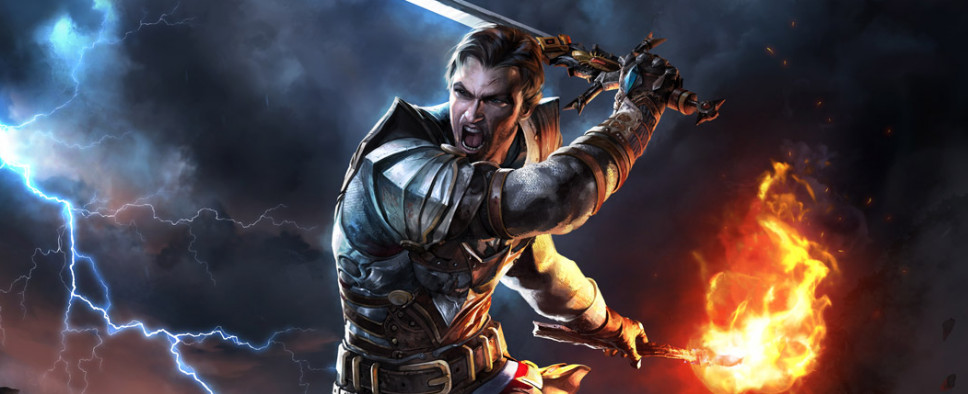Risen 3: Titan Lords Review
-
Category: ReviewsHits: 19931

Article Index
Finally, speaking of exploration, I should note that Piranha Bytes attempted to open up and provide incentives for exploration, unlike Risen 2. While in Dark Waters you would automatically unlock fast travel points which effectively discouraged exploration, in Risen 3 you have to actually find and activate the teleporters before they can serve the same function, provided you have at least one teleporting stone. It's a small change but it's better than Risen 2's system. However, I would have liked to see more done in this direction, for example tying the use of the teleporters to a resource, or requiring the character to reach one to be able to be able to use the teleport system. As it stands, you can simply open the map at any point and automatically teleport to one. The game also has many more climbable surfaces than its predecessor, often placed in less obvious spots, lending the areas more verticality. The action of climbing is simply performed by pressing the jump button near one of them, without any prompt informing you of the possibility. It's also now possible to swim, for the first time in the series, though the implementation leaves much to be desired. The protagonist can't dive underwater, and swimming too far in certain directions will teleport you back after a loading screen, without any explanation given. I understand Piranha Bytes is working under tight budget constraints, but is it really too much to ask for the character to say something like "I'm getting too far away, better go back" or something along those lines? These artificial barriers are especially notable in the island of Calador: a section of the island is blocked by a river of lava, and can only be reached by completing a specific stage of the main quest, but it should be theoretically possible to just swim near the coast to get there. It wouldn't have been difficult to fix that: A simple visual effect near that part of the coast which indicated that the water was boiling and couldn't be crossed would have been enough. For a developer that puts as much of a premium on exploration and freedom as Piranha Bytes, this kind of lazy design is inexcusable.
Character Progression and Gear
Risen 3 utilizes the same character system as Risen 2, with some small tweaks. Just like its predecessor, in Risen 3 you earn Glory by completing quests or killing enemies, which you can then use to raise one of 8 attributes: Melee, Ranged, Cunning, Influence, Toughness, Dexterity, Magic and Spirit.
Each of these attributes determines your base proficiency in the secondary attributes that get used while actually playing the game: Melee determines Piercing Weapons, Slashing Weapons and Swords; Ranged influences Shotguns, Muskets and Critical Hit; Cunning is used for Pistol, Crossbows, Daggers and Critical Hit; Influence for Silver Tongue and Intimidate; Toughness increases Bladeproof, Bulletproof and Resist Magic; Dexterity is used for Pickpocketing and Lock Picking; Magic for Voodoo Magic, Crystal Magic and Rune Magic; and finally, Spirit influences Astral Vision and Alchemy. Most of those attributes are fairly self-explanatory, with perhaps the exception of Astral Vision, Risen 3's completely unnecessary version of the"detective mode" mechanics that have become increasingly common in the last few years.
The third piece of the puzzle are skills, which can be learned from trainers, provided you have enough gold and meet the other requirements. These range from boring flat bonuses to your secondary attributes, to actual game-changers, like the ability to craft certain item types, parry enemy attacks, or add an extra move to your melee combos. It's a system that works fairly decently, but also loses the coarse feeling of progression typical of the studio's earlier works, up to feeling unsubstantial at certain points. By the end of the game I knew fairly well how and why my skill choices affected my character, but I wasn't too sure to what degree my attributes did, given the game doesn't provide anything other than a vague description for their effects. Here and there I also found a few skills with weird requirements that appear intuitive at first but don't actually make much sense mechanically. For example, some melee skills required me to have a high Dexterity, which makes sense until you remember that it's actually the attribute that influences the thieving skills, and has nothing to do with combat.
Similar inconsistencies also present themselves when gear is concerned. Armor progression feels far more substantial, with major, meaningful upgrades reserved for faction armors and a few hidden pieces. Amulets, rings and earrings are designed exactly like in Risen 2, and, as they offer an assortment of minor bonuses to your attributes, lead to the sort of equipment-swapping nonsense that Piranha Bytes used to avoid. In contrast, the weapon progression is well done, with upgrades happening often enough while still feeling substantial. The best weapons are locked behind side content and crafting, though a few of the rarest items, which you can find broken in pieces throughout the world and need to reforge, feel a bit underpowered. As for the actual balance between weapon types, it's better than Risen 2, but still hardly perfect. I've mostly played the game as a melee character that occasionally used pistols and rune magic, but I've had the chance to dabble a bit with the ranged main weapons, and they still felt too powerful. I suppose their trade-off is in terms of playability, as they're simply boring to use.

